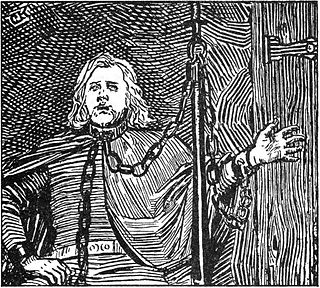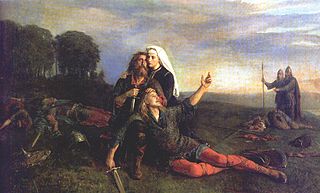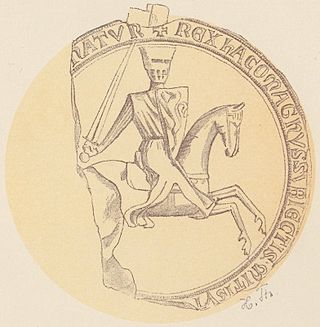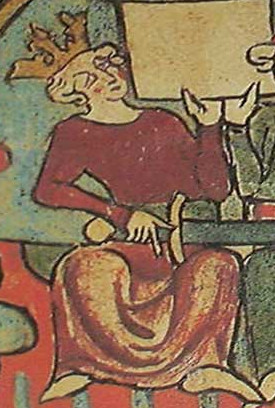Related Research Articles

Þrúðr, sometimes anglicized as Thrúd or Thrud, is a daughter of the major god Thor and the goddess Sif in Norse mythology. Þrúðr is also the name of one of the valkyries who serve ale to the einherjar in Valhalla. The two may or may not be the same figure.

A skald, or skáld is one of the often named poets who composed skaldic poetry, one of the two kinds of Old Norse poetry, the other being Eddic poetry. Skaldic poems were traditionally composed to honor kings, but was sometimes extempore. They include both extended works and single verses (lausavísur). They are characteristically more ornate in form and diction than eddic poems, employing many kennings, which require some knowledge on Norse mythology, and heiti, which are formal nouns used in place of more prosaic synonyms. Dróttkvætt metre is a type of skaldic verse form that most often use internal rhyme and alliteration.
Sagas are prose stories and histories, composed in Iceland and to a lesser extent elsewhere in Scandinavia.
A mansǫngr is a form of Norse poetry. In scholarly usage the term has often been applied to medieval skaldic love-poetry; and it is used of lyric openings to rímur throughout the Icelandic literary tradition.

Bragi Boddason, known as Bragi the Old was a Norwegian skald active in the first half of the 9th century, the earliest known skald from whom verses have survived. Portions of his Ragnarsdrápa are preserved in Snorri Sturluson's Edda.

A legendary saga or fornaldarsaga is a Norse saga that, unlike the Icelanders' sagas, takes place before the settlement of Iceland. There are some exceptions, such as Yngvars saga víðförla, which takes place in the 11th century. The sagas were probably all written in Iceland, from about the middle of the 13th century to about 1400, although it is possible that some may be of a later date, such as Hrólfs saga kraka.
Jómsvikingadrápa is a 13th-century skaldic poem composed by Bjarni Kolbeinsson, Bishop of Orkney. It is a tribute in drápa form to the fallen Jomsvikings at the Battle of Hjörungavágr.
Knýtlinga saga is an Icelandic kings' saga written in the 1250s, which deals with the kings who ruled Denmark since the early 10th century.
Icelandic literature refers to literature written in Iceland or by Icelandic people. It is best known for the sagas written in medieval times, starting in the 13th century. As Icelandic and Old Norse are almost the same, and because Icelandic works constitute most of Old Norse literature, Old Norse literature is often wrongly considered a subset of Icelandic literature. However, works by Norwegians are present in the standard reader Sýnisbók íslenzkra bókmennta til miðrar átjándu aldar, compiled by Sigurður Nordal on the grounds that the language was the same.
Óttarr svarti was an 11th-century Icelandic skald. He was the court poet first of Óláfr skautkonungr of Sweden, then of Óláfr Haraldsson of Norway, the Swedish king Anund Jacob and finally of Cnut the Great of Denmark and England. His poems are significant contemporary evidence for the careers of Óláfr Haraldsson and Cnut the Great.

Hákonar saga Hákonarsonar or Hákonar saga gamla is an Old Norse Kings' Saga, telling the story of the life and reign of King Haakon Haakonarson of Norway.
Hallar-Steinn was an Icelandic poet active around the year 1200. He is best known for the poem Rekstefja, preserved in Bergsbók and Óláfs saga Tryggvasonar en mesta. A few other disjoint verses by him are also known, quoted in Skáldskaparmál, Laufás-Edda and the Third Grammatical Treatise.

The riddarasögur are Norse prose sagas of the romance genre. Starting in the thirteenth century with Norse translations of French chansons de geste and Latin romances and histories, the genre expanded in Iceland to indigenous creations in a similar style.
Steinunn Refsdóttir was an Icelandic skald active at the end of the 10th century. Two verses by her are preserved, in which she taunts the missionary Þangbrandr.
Lotte Motz, born Lotte Edlis was an Austrian-American scholar, obtaining a Ph.D. in German and philology, who published four books and many scholarly papers, primarily in the fields of Germanic mythology and folklore.

The Separate Saga of St. Olaf(Óláfs sögu ins Helga inni sérstöku) is one of the kings' sagas. It was written about King Olaf II of Norway, later Saint Olaf, patron saint of Norway.
Ursula Miriam Dronke was an English medievalist and former Vigfússon Reader in Old Norse at the University of Oxford and an Emeritus Fellow of Linacre College. She also taught at the University of Munich and in the Faculty of Modern and Medieval Languages at Cambridge University.
Merlínússpá is an Old Norse-Icelandic verse translation of Prophetiae Merlini in Geoffrey of Monmouth's Historia regum Britanniae. It is notable for being the only translation of a foreign prose text into poetry in Old Norse-Icelandic literature and for being the earliest Arthurian text to have been translated in medieval Scandinavia. Merlínússpá is preserved in two consecutive parts preserved in the Hauksbók version of Breta sögur. In both Hauksbók and the version of Breta sögur preserved in the manuscript AM 573 4to, the poems are attributed to Gunnlaugr Leifsson. The poem is omitted in AM 573 4to, with the scribe noting that "many people know that poem". Gunnlaugr Leifsson wrote Merlínússpá around 1200. It is a close translation of the Prophetiae Merlini but also includes material from the Historia regum Britanniae.
Skaldic Poetry of the Scandinavian Middle Ages is a project which is editing the corpus of Old Norse-Icelandic skaldic poetry., along with all poetry written down in runes. The project will publish nine volumes and is supported by a website. The corpus comprises 5797 verses by 447 skalds preserved in 718 manuscripts. As of October 2021, five volumes have been published, all of which can be accessed via the project's website.
References
- 1 2 3 Professor Margaret Clunies Ross, Staff profile, Department of English, University of Sydney, 7 December 2010, retrieved 20 January 2011.
- ↑ Gísli Sigurdsson, Review of A History of Old Norse Poetry and Poetics, Speculum 83 (2008) 680-82, p. 680.
- 1 2 Sharon M. Harrison, "Clunies Ross, Margaret Beryl (1942 - )", The Encyclopedia of Women and Leadership in Twentieth-Century Australia, retrieved 27 May 2014.
- ↑ "The Academy Fellows". The Australian Academy of the Humanities. Archived from the original on 28 April 2013. Retrieved 6 April 2016.
- ↑ "Heiðursmerki Fálkaorðunnar", 22 January 2019, retrieved 29 October 2021 (in Icelandic).